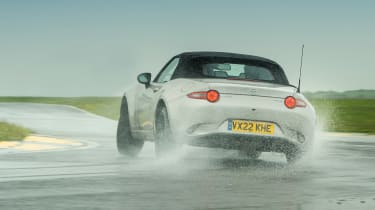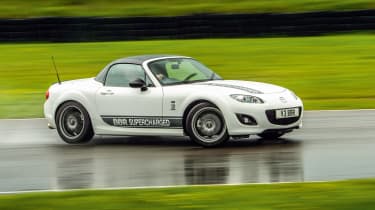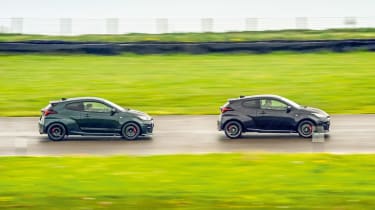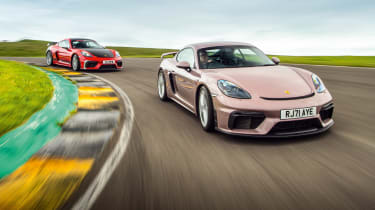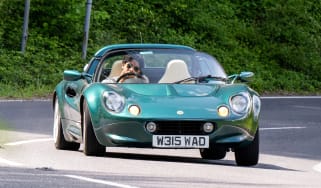Stock v modified: Toyota GR Yaris, Porsche Cayman GT4 & Mazda MX-5
Porsche’s Cayman GT4, Mazda’s MX-5 and Toyota’s GR Yaris are among our favourite track day cars, but can they be improved? We pit standard against modified to find out
'This isn’t panning out quite as expected,’ I think, as I wind on a bit more opposite lock to correct the MX‑5’s trajectory and ensure that its rear wheels kiss the yellow-and-blue kerbing on the exit. The rain is properly lashing down now, but I’m comfortable with how the little Mazda responds, happy that its nose stays hooked up while the rear doesn’t, even in one of the fastest corners. The unexpected bit is that this is the standard MX‑5, the current ‘Sport Tech’ model with 181bhp, rather than the previous-generation BBR GTI tuned car with a supercharged 250bhp that we’re comparing it with. Interesting…
Tuned cars exist for a number of reasons, and in the case of the MX‑5 it’s because from the very first model in 1989 it’s always felt like it could handle a bit more power. BBR has been satisfying that demand almost from the start, supplying a turbocharger kit officially through Mazda dealers for the Mk1 MX‑5. Yet on track at Anglesey in the rain, this standard current ‘ND’ model feels beautifully balanced, dynamically and as a package. Same goes for the stock GR Yaris and 718 Cayman GT4: they each feel right at home on the circuit, tucking in eagerly to its slower turns, playful, adjustable and predictable. Seems like the BBR MX‑5 and 320bhp Litchfield-modified Yaris have their work cut out, as does the RPM Technik-fettled GT4 MR with its shorter gearing and Manthey Racing suspension.
> Porsche 718 Cayman GT4 RS 2022 review – the ultimate mid-engined sports car
Alongside the last-generation BBR car, the current MX‑5 appears delicate, spindly on its narrow-shod 17-inch wheels, its body looking as if the edges have been shaved off with a gigantic file, removing material to make it as light as possible. In a world of spiralling kerb weights, you have to admire Mazda’s commitment to reducing weight over the previous model. With a full tank, the MX‑5 measured 1073kg on our scales. That’s not much more than an Elise, yet there is a stylish, fully stocked, fully trimmed cockpit.
A clue to the quality and delicacy of the MX‑5’s handling comes from the steering wheel, which has a thin rim and is bound in a lovely, soft, smooth leather. It ought to feel a bit out of place on a circuit, especially one with a couple of long, high-speed sections, and if it was dry it might, but with suspension that’s soft vertically and in roll, it feels well-suited to the wet conditions. As standard, the Sport Tech model has Bilstein dampers and a limited-slip diff, which help make it remarkably effective. Its narrow Bridgestones hang on admirably, but you can sense there’s fun to be had through getting on the power earlier and earlier and bringing the rear fully into play.
Stability control turned off, there’s sufficient grunt from the engine to push the rear wide in slow-to-medium-speed corners and keep it there for a while, the MX‑5 dancing on the wet surface. The best cars look after you when you venture into new territory, responding in a way that lets you know the engineers have been there before you. That moment in the MX‑5 comes in the fast right-hander onto the back straight. Not wanting to lose any hard-won speed, I turn in at around 70mph, the nose takes the line obediently… and the rear slides gently wide. Slightly panicked, I fish for the correct amount of opposite lock and discover the steering is calm and doesn’t upset the car.
BBR makes tuning kits for all generations of MX‑5 but we (dep ed Towler, actually) chose the 250bhp, supercharged NC for a few reasons. First, because it’s one of the best we’ve driven, second because it shows that you can get a properly quick, rear-drive sports car for £20k (a used NC MX‑5 for £10k and the BBR engine and chassis upgrades for another £10k) and third because it’s a bit roomier than the ND, so dep ed Towler will fit in it.
This car, weighing in at 1202kg, has been BBR’s demonstrator for a few years now and has racked up over 35,000 miles, and it’s a testimony to the build quality of the base car that it feels almost box-fresh. It’s not quite as stylish inside as the ND but there’s the same short and snappy gearshift and lightweight feel, and an engine that’s got a bit more character thanks to the supercharger. Oh, and a whole lot more power and torque, of course.
BBR’s lowered and stiffened suspension (adjustable Koni dampers revalved to suit BBR springs) is paired with Michelin Pilot Sport 4 S tyres, and it’s an effective combo. Unexpectedly, the fatter-rimmed steering wheel offers less weight and, I soon establish, there’s less front-end bite too on the rain-slick asphalt, though that can be seen simply as an invitation to test your throttle and opposite-lock skills. There’s an abundance of torque delivered in a more linear, predictable fashion than would be the case with a turbocharger, so you can get just what you need, whether that’s just enough to neutralise the understeer or a bootful to kick the tail out and keep it hanging there in oversteer equilibrium. Either way, it’s much faster between the corners than the standard car, and if it was dry it would romp away in a couple of corners. But whether standard or tuned, the MX-5 is impossible to ignore as a driver’s car.
The track was dry when we went out in the Yarises and, continuing the theme, the standard example – here in Circuit Pack spec – proves remarkably biddable and resolutely hooked-up. It’s not especially sharp in feel but it settles into a satisfying flow around the lap and, with stability control disabled and Track mode selected, it turns in, hangs on and powers out without ever feeling like it’s punishing its tyres. Impressive considering our scales show that its 1280kg is split 60/40 front/rear, so it’s quite nose-heavy. It feels like it’s got closer to 300bhp than the quoted 257bhp, with a firm delivery right the way through to 7000rpm.
There’s plenty of scope for improvement, though, and if you want more punch, more bite and more thrills, what you need is the standard Yaris’s evil twin, the 320bhp Litchfield Yaris.
It weighs in at 13kg heavier than the standard car and is winning even before it’s turned a wheel. Just look at its stance, and that colour. The dark metallic green paint is actually a painted wrap that Litchfield calls Paint Protection Spray. Nitron suspension sits the car lower, while filling the arches perfectly are wider (at 9.5 inches) Protrack rims that weigh about the same as the stock items but are shod with semi-slick but road-legal Nankang AR1s, which are very heavy. Litchfield is trying them having seen them on a few customers’ Nissan GT‑Rs. The only other trackday tyre that lasts on the heavyweight Nissan is the Toyo R888R. The Nankangs are not only more reasonably priced, they will also survive three or four trackdays, Litchfield says.
A remap lifts power and torque to 320bhp and 320lb ft with the help of a new intercooler, and there’s a fruitier exhaust too, but perhaps the biggest win of all is inside, where you’ll find lowered seats. The standard ones sit you oddly high and, for some, preclude the wearing of helmets. The drop of 40-50mm solves this problem and improves the driving position generally, while the replacement Corbeau seats are trimmed to match the rest of the interior.
While the standard car has a soft, loping, three-cylinder burble, this car fires up with a rawer, more hollow and resonant bark. You can feel the increased suspension stiffness from the off but for the first couple of laps I find myself distracted by the immense amount of noise created by the semi-slick Nankangs. It’s a rolling rumble that makes it sound like the tyres aren’t round. A lap or two later they’re warming up and starting to deliver an amazing amount of grip, but are still noisy. The uprated engine punches much harder when you step on the throttle mid-corner but it never feels like it’s going to get the better of the grip, the result being thrilling, sling-shot exits from corners.
Dynamically, it’s not quite sorted. This is the first time it’s been on these tyres and its first time at Anglesey, and the adjustable Nitron suspension is probably a bit stiff at the front and soft at the rear. It’s revealing bumps that go unnoticed in other cars, nose a‑bobbing in the braking area for the big, cambered hairpin, while at the surface change on the off-camber corner onto the pit straight it’s lifting a front wheel. Of course, part of the fun with a modified car is being able to tweak it to maximise performance or adjust it to the conditions.
With the standard GR Yaris already proving popular at trackdays while also being a car that responds well to a tuner’s deft touch, you can expect its paddock popularity to continue for some time to come.
There is no such thing as an unimprovable car, but some get closer to perfection than others. The 718 Cayman GT4 falls into the category of almost flawless. Our Car of the Year 2019 is a properly exciting and rewarding sports car that oozes character. It has a gearshift that’s short, snickety and as slick as if the lever dropped straight into the gearbox, while the swirling, detailed, gravelly note of the 4-litre flat-six is a shifting, evolving aural delight as it climbs from tickover to red line. Add in a perfectly judged brake pedal that makes heel-and-toe shifts a cinch, steering that feels meaty at low speed but is perfectly weighted and tactile in corners, and a chassis that’s poised and connected, and it’s five stars all day long.
But it’s not perfect because the gear ratios of the six-speed manual are monumentally and occasionally frustratingly long. This is perhaps best illustrated by the fact that peak power (at 7600rpm) in second gear is 80mph, so in the UK you can only legally hit the red line on the public road in first. Oddly, such long gearing doesn’t feel like a great handicap on track. Most of the lap is in second gear, with third on the longer sections, and it’s such a flexible, torquey engine that it can still test the chassis at almost every corner, so you’re not missing the ability to adjust the balance with the throttle. The chassis is wonderfully transparent and malleable: dive for the apex, back off to shift the weight forward, get back on the throttle and exit with the car neutral or with as much oversteer as you want (and a trackday will allow…).
Consequently, the benefits of the work of Porsche specialist RPM Technik are not as immediately apparent as you might expect. RPM has developed a new crownwheel and pinion that lowers the gearing by 14 per cent, so peak power in second gear is now at 69mph and in third 96mph (instead of 111mph). There’s also a lightweight flywheel but the engine delivers the same 414bhp and it rides on the same Michelin Cup 2 tyres. It is on lower, stiffer suspension developed by legendary Porsche fettlers Manthey Racing, but, as with the Litchfield Yaris, it hasn’t been dialled in for Anglesey and there is a little front-end push in the fastest corners. The upshot is that there is more kick available mid-corner, but as this is something that isn’t obviously missing in the standard car, it seems only a marginal gain.
The twist is that I drove to Anglesey in the standard GT4 in convoy with RPM Technik’s commercial director, Darren Anderson, in the GT4 MR. We took the interesting route across country from Welshpool and I thought the stock GT4 had held its own. However, within a couple of miles of slipping behind the wheel of the GT4 MR I was utterly gobsmacked; on the road the shorter gearing completely transforms the experience.
Suddenly the GT4 is alive, ever-ready with a solid slug of torque or power, and it revs out so much more quickly there’s so much more urgency to the car. Whatever the speed, it responds harder and quicker and revs faster, which changes the character of the engine, giving it an almost VTEC-like appetite. And thanks to the lightweight flywheel, heel-and-toe shifts are snappier and the shift feels even slicker. It’s sensational: a different, better car, almost like the regular GT4 but 200kg lighter. (On that subject, we weighed the stock car at 1460kg and the MR at 1439kg.) And, at a road pace, the chassis feels spot-on too, carrying speed more confidently into corners and never feeling weighty, which the standard car can occasionally.
So, the unexpected conclusion is that the standard road cars are great fun on track and the tuned cars are great, too, but even better on the road. Why? Because on the road you don’t have the freedom to get cars moving about, so you want sharper, more precise steering and more immediate engine and braking response. I’d driven the Litchfield Yaris previously on standard wheels and tyres and, even without the trackday rubber, it’s a much more positive car dynamically and puts an ever-ready slug of torque at your disposal, too. It also gives you a better seat from which to enjoy the action, of course. The BBR MX‑5 is also a more composed, punchier road car that delivers a more focused, more intense drive. But the most dramatic transformation is wrought by the lower final drive and lightweight flywheel in the Cayman GT4 MR. It’s astonishing how much more performance is available and how much keener it feels. The standard road cars are great, but the right mods make them greater.
This story was first featured in issue 299.


